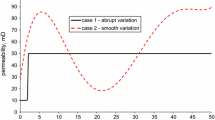Abstract
The problem of calculating equivalent grid block permeability tensors for heterogeneous porous media is addressed. The homogenization method used involves solving Darcy's equation subject to linear boundary conditions with flux conservation in subregions of the reservoir and can be readily applied to unstructured grids. The resulting equivalent permeability tensor is stable as defined relative to G-convergence. It is proposed to use both conforming and mixed finite elements to solve the local problems and compute approximations from above and below of the equivalent permeability, respectively. Comparisons with results obtained using periodic, pressure and no-flux boundary conditions and the renormalization method are presented. A series of numerical examples demonstrates the effectiveness of the methodology for two-phase flow in heterogeneous reservoirs.
Similar content being viewed by others
References
B. Amaziane, Global behavior of compressible three-phase flow in heterogeneous porous media, Transport in Porous Media 10 (1993) 43–56.
B. Amaziane and M. Batchi, Effective relative permeabilities and capillary pressure of a three-phase flow model in heterogeneous porous media, in: Computer Methods and Water Resources III, eds. Y. Abousleiman et al. (Computational Mechanics Publications, Boston, 1996) pp. 303–314.
B. Amaziane and A. Bourgeat, Effective behavior of two-phase flow in heterogeneous reservoir, in: Numerical Simulation in Oil Recovery, ed. M.F. Wheeler, The IMA Volumes in Mathematics and its Applications, Vol. 11 (Springer, New York, 1988) pp. 1–22.
B. Amaziane, A. Bourgeat and J. Koebbe, Numerical simulation and homogenization of two-phase flow in heterogeneous porous media, Transport in Porous Media 6 (1991) 519–547.
A. Badea and A. Bourgeat, Homogenization of two phase flow through randomly heterogeneous porous media, in: Proc. of the Conference on Mathematical Modelling of Flow through Porous Media, eds. A. Bourgeat et al. (World Scientific, Singapore, 1995) pp. 44–58.
A. Badea and A. Bourgeat, Numerical simulations by homogenization of two-phase flow through randomly heterogeneous porous media, in: Notes on Numerical Fluid Mechanics, Modeling and Computation in Environmental Sciences, Vol. 59, eds. R. Helmig et al. (1997) pp. 13–24.
A. Bamberger, Approximation des coefficients d'opérateurs elliptiques, stable pour la G-convergence, Publications du Centre de Mathématiques Appliquées de l'Ecole Polytechnique, No. MAP/15 (1977).
J. Bear and Y. Bachmat, Introduction to Modeling of Transport Phenomena in Porous Media (Kluwer Academic, London, 1991).
A. Bourgeat, Homogenized behavior of two-phase flow in naturally fractured reservoirs with uniform fractures distribution, Comput. Methods Appl. Mech. Engrg. 47 (1984) 205–216.
A. Bourgeat and A. Hidani, Effective model of two-phase flow in a porous medium made of different rock types, Applicable Analysis 58 (1995) 1–29.
A. Bourgeat, S.M. Kozlov and A. Mikelic, Effective equations of two-phase flow in random media, Calc. Var. 3 (1995) 385–406.
F. Brezzi and M. Fortin, Mixed and Hybrid Finite Element Methods (Springer, New York, 1991).
P.G. Ciarlet, The Finite Element Method for Elliptic Problems (North-Holland, Amsterdam, 1978).
L.J. Durlofsky, Numerical calculation of equivalent grid block permeability tensors for heterogeneous porous media, Water Resour. Res. 27 (1991) 699–708.
L.J. Durlofsky and E.Y. Chung, Effective permeability of heterogeneous reservoirs regions, in: Proc. of the 2nd European Conf. on the Mathematics of Oil Recovery, eds. D. Guérillot and O. Guillon (Technip, Paris, 1990) pp. 57–64.
L.J. Durlofsky, R.C. Jones and W.J. Milliken, A new method for the scale up of displacement processes in heterogeneous reservoirs, in: Proc. of the 4th European Conf. on the Mathematics of Oil Recovery, Røros, Norway, 1994.
M.S. Espedal and O. Sævareid, Upscaling of permeability based on wavelet representation, in: Proc. of the 4th European Conf. on the Mathematics of Oil Recovery, Røros, Norway, 1994.
T. Gallouët and D. Guérillot, An optimal method for averaging the absolute permeability, in: Proc. of the 3rd Internat. Reservoir Characterization Technical Conf., Tulsa, OK, 1991.
V. Girault and P.A. Raviart, Finite Element Methods for Navier–Stokes Equations (Springer, Berlin, 1986).
A. Hidani, Modélisation des écoulements diphasiques en milieu poreux à plusieurs types de roches, Thèse de Doctorat, Université de Saint-Etienne (1993).
U. Hornung, Homogenization and Porous Media, Interdisciplinary Applied Mathematics (Springer, Berlin, 1997).
V.V. Jikov, S.M. Kozlov and O.A. Oleinik, Homogenization of Differential Operators and Integral Functionals (Springer, Berlin, 1994).
P.R. King, The use of renormalisation for calculating effective permeability, Transport in Porous Media 4 (1989) 37–58.
J. Koebbe, A computationally efficient modification of mixed finite element methods for flows problems with full transmissivity tensors, Numer. Methods Partial Differential Equations 9 (1993) 339–355.
J. Nedelec, Mixed finite elements in ℝ3, Numer. Math. 13 (1992) 887–898.
G.E. Pickup, P.S. Ringrose, J.L. Jensen and K.S. Sorbie, Permeability tensors for sedimentary structures, Mathematical Geology 26 (1994) 227–250.
P.A. Raviart and J.M. Thomas, A mixed finite element method for second order elliptic problems, in: Mathematical Aspects of the Finite Element Method, eds. I. Galligani and E. Magenes, Lecture Notes in Mathematics, Vol. 606 (Springer, Berlin, 1977) pp. 292–315.
J.E. Roberts and J.M. Thomas, Mixed and hybrid methods, in: Handbook of Numerical Analysis, Finite Element Methods (Part 1), Vol. II, eds. P.G. Ciarlet and J.L. Lions (North-Holland, Amsterdam, 1991) pp. 524–639.
K. Sab, On the homogenization and the simulation of random materials, European J. Mech. A 11 (1992) 585–607.
A.E. Saez, C.J. Otero and I. Rusinek, The effective homogeneous behavior of heterogeneous media, Transport in Porous Media 4 (1989) 213–238.
P. Samier, A finite element method for calculating transmissibilities in n-point difference equations using a non-diagonal permeability tensor, in: Proc. of the 2nd European Conf. on the Mathematics of Oil Recovery, eds. D. Guérillot and O. Guillon (Technip, Paris, 1990) pp. 121–130.
Author information
Authors and Affiliations
Rights and permissions
About this article
Cite this article
Amaziane, B., Hontans, T. & Koebbe, J. Equivalent Permeability and Simulation of Two-Phase Flow in Heterogeneous Porous Media. Computational Geosciences 5, 279–300 (2001). https://doi.org/10.1023/A:1014508622020
Issue Date:
DOI: https://doi.org/10.1023/A:1014508622020




